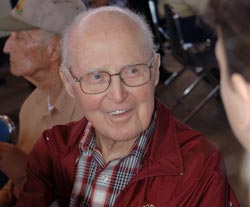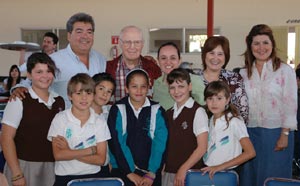CIMMYT E-News, vol 4 no. 4, April 2007
Having just celebrated his 93rd birthday, the man who was at the heart of the creation of CIMMYT, Dr Norman Borlaug, visits the Yaqui Valley to meet his old friends: the farmers with whom he worked 60 years ago, the first beneficiaries of what we call the Green Revolution in agriculture.
Until you visit Ciudad Obregón, Sonora State, in northwestern Mexico, it is hard to understand the depth of feeling the citizens of that region have for Nobel Peace Prize laureate, Norman Borlaug. Though an American, he lived in the Yaqui Valley of Sonora State, where Ciudad Obregón is located, for many years starting in 1947. He and a small research team worked with the government of Mexico and the Rockefeller Foundation to improve the nation’s agricultural capacity. Borlaug’s responsibility was wheat. The Yaqui Valley farmers were poor and wheat a marginal crop, succumbing regularly to rust diseases; Mexico had to import 60% of its wheat. Under Borlaug’s leadership, researchers overcame the rust problem and pioneered the development of short-statured wheat. Nearly half the new plants’ weight was grain, and the stems were short and strong enough to stay erect until harvest. By the 1960s farmers in the valley had improved food security and incomes.
In recent years, Borlaug’s visits to the Yaqui Valley have been much less frequent, but the bond between Borlaug and Valley inhabitants has not diminished. In Ciudad Obregón a major street is named Avenida Norman Borlaug. He is depicted in a historical mural in City Hall as a pioneering father. Area hotels have meeting rooms named after him. When he stepped off the plane from Texas, where he had undergone medical treatment, airport staff, fire fighters, and ground crews formed a line from the steps of the aircraft toward the terminal building. “It wasn’t quite a red carpet, but it was red carpet treatment,” said Chris Dowswell, Borlaug’s Special Assistant.
Clearly the people of the Yaqui Vally have never forgotten. For decades the farmer organization of Sonora State (known locally as the Patronato) has provided rent-free land for experimentation to CIMMYT and INIFAP, the national agricultural research program of Mexico. The institutes have side-by-side facilities close to their experimental fields.
A meeting of green-seekers
 Borlaug, still a consultant with CIMMYT, is also the President of the Sasakawa Africa Association, which is devoted to improving the lives of the rural poor in sub-Saharan Africa. One of his reasons for visiting Obregón this time was to see and learn about a technology developed by Oklahoma State University (OSU) and CIMMYT. The approach allows farmers easily and cheaply to determine the optimum application of fertilizer for a developing wheat or maize crop. Fertilizer resources are scarce in much of Africa, so timely application of the correct amounts can save farmers money and help produce a better crop.
Borlaug, still a consultant with CIMMYT, is also the President of the Sasakawa Africa Association, which is devoted to improving the lives of the rural poor in sub-Saharan Africa. One of his reasons for visiting Obregón this time was to see and learn about a technology developed by Oklahoma State University (OSU) and CIMMYT. The approach allows farmers easily and cheaply to determine the optimum application of fertilizer for a developing wheat or maize crop. Fertilizer resources are scarce in much of Africa, so timely application of the correct amounts can save farmers money and help produce a better crop.
The technology, known as GreenSeeker, uses a special sensor to measure infrared and near-infrared light reflected from the leaves of growing plants. A hand-held computer, programmed with the data about the crop and location can calculate the nitrogen status of the plant. Ivan Ortiz-Monasterio, who leads CIMMYT’s research in nitrogen efficiency, says many Yaqui Valley farmers can recover the cost of the sensor in a single season through savings in fertilizer use, but acknowledges the economics on smallholder farms in Africa are quite different. OSU researchers are now taking on the challenge of producing a less expensive model that will work for the rural poor in Africa.
Research: The icing on agriculture’s cake?
In a speech to the farmers, extension workers, and researchers, Borlaug explained the plight of the resource poor in Africa and how a technology like the GreenSeeker might make a difference. In one farmer’s field he was given a demonstration and explanation of the device and how to use it. One of the messages that came through loud and clear was this: without research in agriculture, there would be no progress.

That was what the farmers of the valley learned from Borlaug and his team more than half a century ago, and they heard it again when he came back. Today the farmers have passed down their pride in the original work done at Obregón, first to their children and now, their grandchildren. At a luncheon at the CIMMYT research station, students from Colegio Teresiano de la Vera Cruz in Ciudad Obregón presented Borlaug with a birthday cake. They had just completed a project for the school’s cultural week that focused on Borlaug and his work in the Yaqui Valley. From Borlaug to the people of the Yaqui Valley, and from the people themselves, it is clear that the commitment made 60 years ago continues.
For more information: Christopher Dowswell (c.dowswell@cgiar.org).
 Capacity development
Capacity development 
